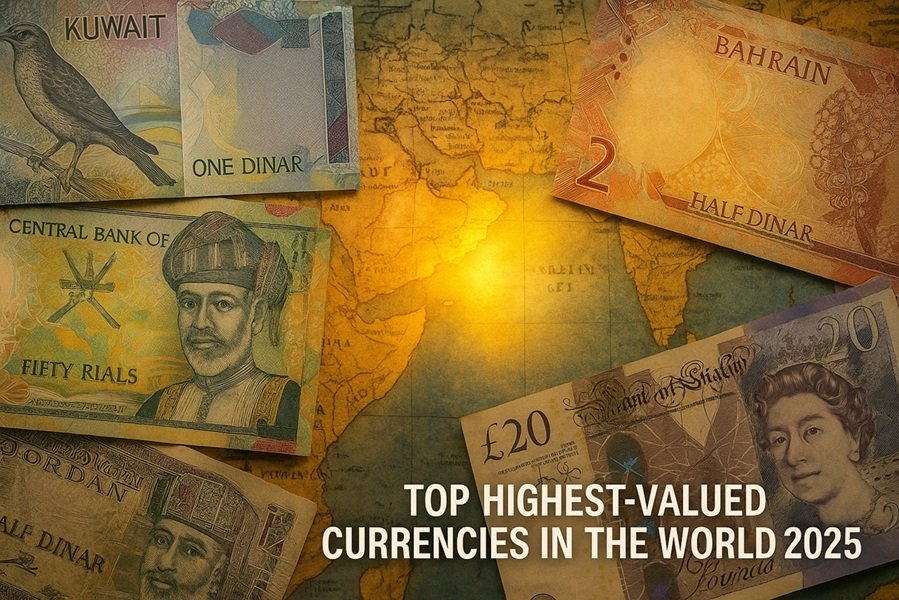
Introduction
In the global economy, the value of a country’s currency is a crucial indicator of its financial strength, stability, and geopolitical influence. While the US Dollar (USD) is the most widely used and traded currency in the world, it is not the most valuable in terms of exchange rate. In this comprehensive 2025 guide, we examine the top highest value currencies in the world and the reasons behind their strong valuation.
What Determines a Currency’s Value?
Before diving into the list, it’s important to understand what makes a currency valuable:
- Exchange rate against USD (most commonly used for comparison)
- Foreign reserves and trade balance
- Oil and natural resource exports
- Economic stability and low inflation
- Geopolitical security
- Demand in foreign exchange markets
Top 10 Highest Value Currencies in the World (2025)
Here is the updated list based on exchange rates as of May 2025:
| Rank | Currency Name | Country | 1 Unit = USD (Approx.) |
|---|---|---|---|
| 1️⃣ | Kuwaiti Dinar (KWD) | Kuwait | $3.26 USD |
| 2️⃣ | Bahraini Dinar (BHD) | Bahrain | $2.65 USD |
| 3️⃣ | Omani Rial (OMR) | Oman | $2.60 USD |
| 4️⃣ | Jordanian Dinar (JOD) | Jordan | $1.41 USD |
| 5️⃣ | British Pound Sterling (GBP) | United Kingdom | $1.27 USD |
| 6️⃣ | Gibraltar Pound (GIP) | Gibraltar | $1.27 USD |
| 7️⃣ | Cayman Islands Dollar (KYD) | Cayman Islands | $1.20 USD |
| 8️⃣ | Euro (EUR) | European Union | $1.08 USD |
| 9️⃣ | Swiss Franc (CHF) | Switzerland | $1.11 USD |
| 🔟 | US Dollar (USD) | United States | $1.00 USD |
Detailed Analysis of the Top Currencies
1. Kuwaiti Dinar (KWD) – Most Valuable Currency in 2025
- Exchange Rate: 1 KWD ≈ 3.26 USD
- Why so valuable?
- Massive oil exports
- Strong foreign reserves
- Stable political structure
- Fun Fact: The Kuwaiti Dinar has held the #1 spot for several years, backed by its oil-rich economy and pegged exchange rate.
2. Bahraini Dinar (BHD)
- Exchange Rate: 1 BHD ≈ 2.65 USD
- Strength Factors:
- Oil-dominated economy
- Currency peg to USD
- Controlled inflation and fiscal stability
3. Omani Rial (OMR)
- Exchange Rate: 1 OMR ≈ 2.60 USD
- Why high value?
- Limited circulation
- Fixed peg system
- Strategic oil trade position in the Gulf
4. Jordanian Dinar (JOD)
- Exchange Rate: 1 JOD ≈ 1.41 USD
- Interesting Point: Jordan has few natural resources, yet the Dinar remains strong due to fixed exchange policy and strong remittance inflows.
5. British Pound Sterling (GBP)
- Exchange Rate: 1 GBP ≈ 1.27 USD
- Strength Drivers:
- UK’s diversified economy
- Global influence in finance
- Pound’s historical significance
6. Gibraltar Pound (GIP)
- Exchange Rate: 1 GIP ≈ 1.27 USD (par with GBP)
- Notes: Pegged 1:1 to the British Pound and accepted interchangeably in Gibraltar.
7. Cayman Islands Dollar (KYD)
- Exchange Rate: 1 KYD ≈ 1.20 USD
- Reason for Strength:
- Tax haven status
- Low inflation
- Financial service sector dominance
8. Euro (EUR)
- Exchange Rate: 1 EUR ≈ 1.08 USD
- Why important?
- Used by 20+ European countries
- Strong central regulation by the European Central Bank (ECB)
9. Swiss Franc (CHF)
- Exchange Rate: 1 CHF ≈ 1.11 USD
- Trust Factors:
- Neutrality of Switzerland
- Banking secrecy and strong economy
- Low inflation and safe-haven asset
10. US Dollar (USD)
- Exchange Rate: 1 USD ≈ 1.00 USD (base value)
- Why globally dominant?
- Reserve currency of the world
- Used in ~90% of global forex transactions
- Backed by the largest economy
Notable Mentions (Currencies with Stable Value)
- Singapore Dollar (SGD): Strong in Southeast Asia due to advanced banking and innovation sectors.
- Brunei Dollar (BND): Pegged to SGD and backed by oil exports.
- Australian Dollar (AUD): Resource-rich economy with high global trade volumes.
- Canadian Dollar (CAD): Energy exporter and economically stable.
High Value ≠ Strong Economy: Clarification
It’s a common misconception that currency value directly reflects economic strength. For instance:
- Japan and China have huge economies, yet the Japanese Yen and Chinese Yuan are not high in exchange rate value.
- This is often due to intentional monetary policies, export advantages, and inflation management.
Factors That Affect Currency Value in 2025
- Oil Prices: Gulf countries with oil-based currencies like KWD, BHD, OMR benefit.
- Interest Rates & Inflation: Higher interest rates usually support stronger currencies.
- Geopolitical Events: Wars, elections, or instability can lower a currency’s value.
- Central Bank Actions: Currency pegs, quantitative easing, or reserve management affect strength.
Conclusion
In 2025, the Kuwaiti Dinar (KWD) remains the most valuable currency in the world, thanks to its oil wealth and pegged exchange system. However, value is relative and does not always translate into economic dominance. Currencies like the US Dollar and Euro maintain massive global influence, while high-value currencies like the Omani Rial remain limited to regional strength.
Understanding currency values gives deep insight into the economic, political, and trade health of nations. Whether you’re a traveler, investor, or student of economics, knowing the top currencies and their backgrounds helps interpret global financial trends more clearly.






